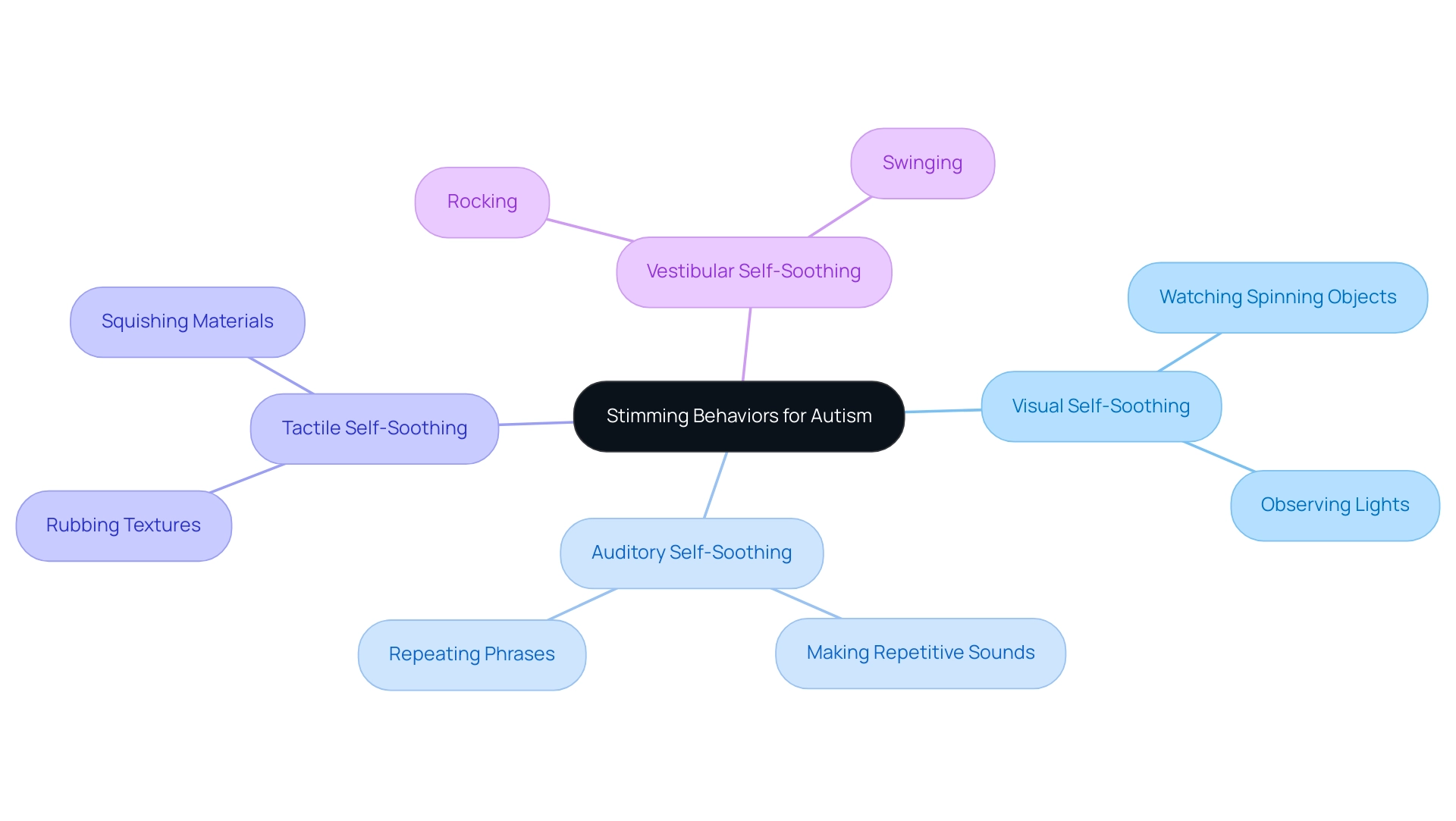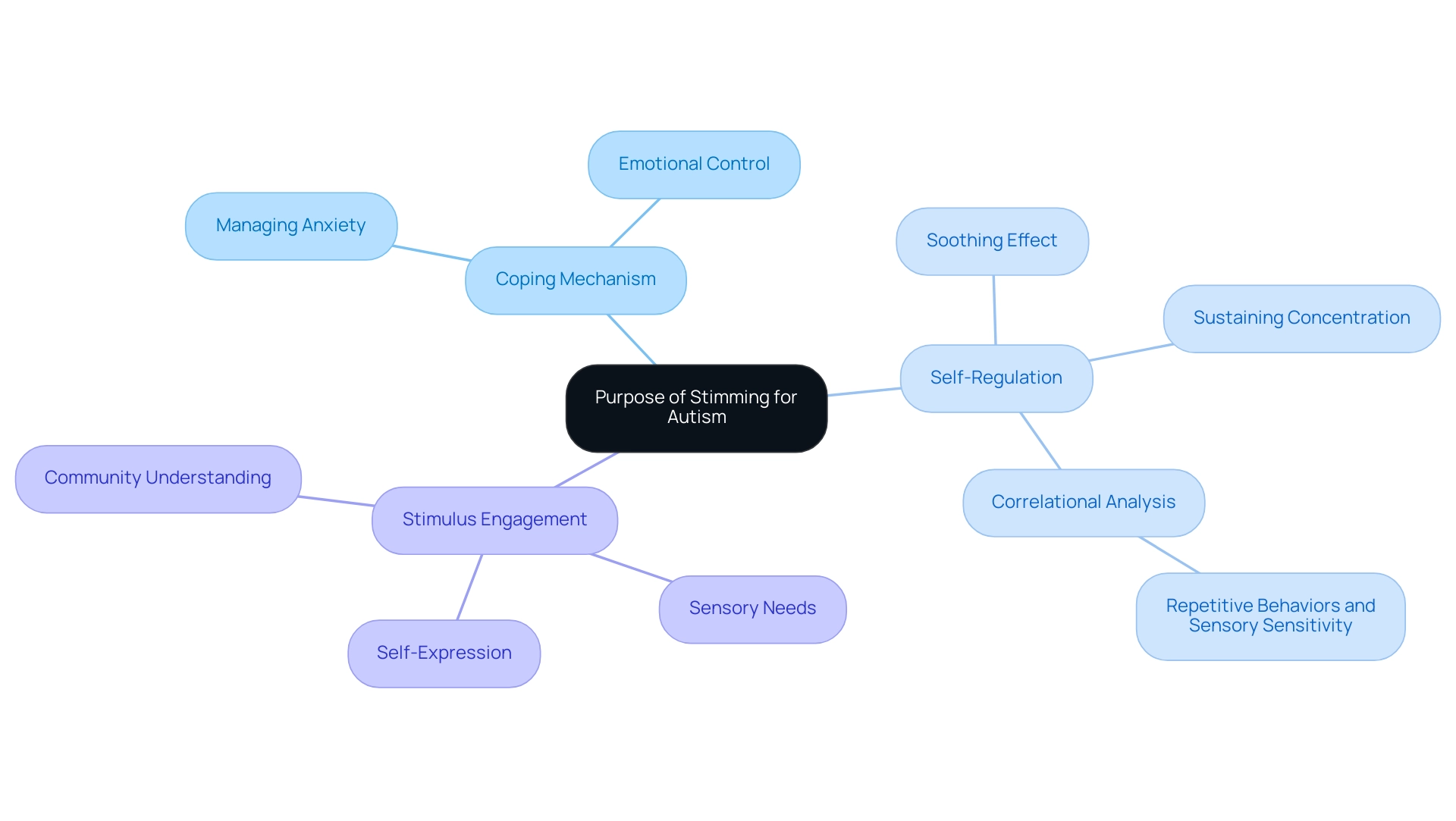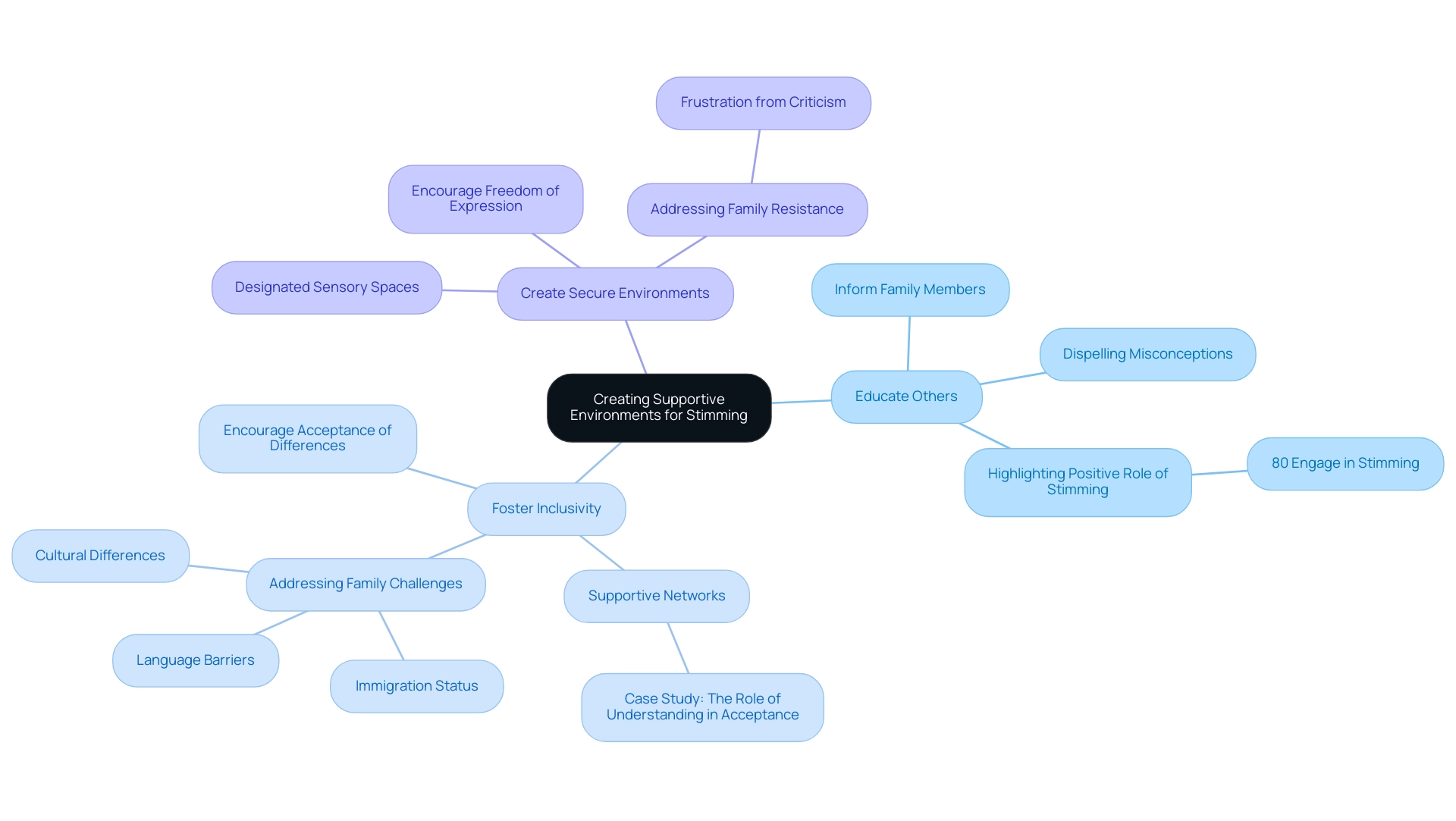Overview
Stimming for autism is a self-stimulatory behavior that serves critical functions such as emotional regulation, sensory engagement, and self-soothing for individuals on the autism spectrum. The article emphasizes the importance of understanding these behaviors for caregivers, as they can significantly enhance communication and emotional bonds while also addressing the challenges and stigma associated with stimming in social contexts.
Introduction
In the intricate landscape of autism, stimming—self-stimulatory behavior—emerges as a vital expression of sensory needs and emotional regulation. Often misunderstood, these repetitive actions, ranging from hand-flapping to vocalizations, serve not only as coping mechanisms but also as crucial communication tools for individuals on the spectrum.
As recent studies reveal significant correlations between stimming behaviors and sensory sensitivities, it becomes essential for caregivers and society to embrace these actions as legitimate forms of self-expression. By delving into the various types and purposes of stimming, as well as the challenges and benefits associated with it, this article aims to illuminate the importance of understanding and supporting these behaviors, ultimately fostering a more inclusive environment for those who stim.
What is Stimming? Defining the Behavior
Stimming for autism, which refers to self-stimulatory activity, encompasses a range of repetitive movements, either of the body or objects, that are frequently observed in individuals with autism. Common forms of self-stimulatory behavior include:
- Hand-flapping
- Rocking
- Spinning
- Various vocalizations
Comprehending stimming for autism is essential for caregivers, as these actions often serve as important communication tools. They allow individuals to express emotions, regulate input, and manage stress effectively.
Recent studies, including a correlational analysis of repetitive actions and sensory sensitivity, reveal highly significant correlations between these actions across both diagnosed and undiagnosed autistic groups, indicating a consistent pattern of relationships. This highlights the importance for caregivers to identify and understand self-soothing actions, enabling them to react in a helpful way.
As Rebecca aptly notes,
But, they should because they’re my family
—an acknowledgment of the significance of familial understanding of these actions.
Additionally, while the primary somatosensory cortex in mice is dominated by the barrel field, which contains the representation of single facial whiskers, this context can provide insights into sensory processing relevant to understanding repetitive sensory behaviors in humans. It is also essential to acknowledge the limitations of current studies, including the lack of systematic data on participants' clinical functioning and certain demographics, which highlights the complexities involved in examining these actions.
By understanding the role of sensory behaviors, caregivers can promote improved communication and emotional bonds with people on the autism spectrum by utilizing stimming for autism.
Exploring Different Types of Stimming Behaviors
Stimming for autism encompasses various activities, also referred to as self-stimulatory actions, which can be classified into several distinct types, each serving a unique role in perception integration and emotional management. Comprehending these classifications is vital for caregivers in effectively recognizing and addressing their children's needs:
- Visual Self-Soothing: This includes activities such as watching spinning objects or lights, which can provide visual stimulation and comfort.
- Auditory Self-Soothing: Involves making repetitive sounds or phrases, allowing people to experience auditory feedback that can be soothing or engaging.
- Tactile Self-Soothing: Engaging with various textures—like rubbing or squishing materials—offers a tactile experience that can help with self-soothing and exploration.
- Vestibular Self-Soothing: This encompasses movements that involve balance, such as rocking or swinging, which can help people orient themselves in space and regulate their body sensations.
Recent research highlights that engaging in stimming for autism can significantly assist individuals in regulating emotions, reducing stress and anxiety, improving concentration, and enhancing overall well-being. According to studies, stimming for autism can result in a 30% reduction in anxiety levels among individuals with autism. As one autism advocate, Rebecca, expressed, “I’m angry that they’ve been told a thousand times why I do it, the reason behind it, that it’s not affecting anyone.” This sentiment highlights the importance of acknowledging self-soothing actions as a legitimate expression of sensory needs rather than an action requiring correction.
Incorporating the views of autistic adults is essential for understanding these actions, as they provide firsthand insights into their significance. Furthermore, strategies for managing self-soothing actions, such as identifying alternative methods to regulate emotions or seeking assistance from therapists, empower caregivers with practical approaches. By understanding the various forms of stimming for autism and the perspectives of those who experience them, caregivers can better support their children and promote healthier coping mechanisms.

Understanding the Purpose of Stimming: Coping and Self-Regulation
Stimming for autism plays various crucial roles for individuals on the autism spectrum. These include:
- Coping Mechanism: Stimming serves as an essential tool for managing anxiety, providing individuals an outlet during overwhelming situations. Studies have demonstrated that these actions can greatly lower stress levels, rendering them an important approach for emotional control.
- Self-Regulation: Participating in self-soothing activities can aid in sustaining concentration and offer a soothing effect in tense situations. The recent correlational analysis of repetitive actions and sensitivity highlights a consistent pattern across both diagnosed and undiagnosed autistic groups, demonstrating a strong link between these actions and enhanced self-regulation. Significantly, this analysis uncovered highly important correlations among all measures, indicating a consistent relationship between repetitive behaviors and sensitivity to stimuli.
- Stimulus Engagement: Repetitive behaviors often fulfill a sensory need, providing comfort through repetitive actions. This sensory engagement is not simply a behavior to be minimized; instead, it is a valid means of self-expression that promotes a sense of security and well-being. Moreover, a survey involving 160 adults with an autism diagnosis, 139 suspected autistic adults, and 41 non-autistic adults highlights the prevalence and significance of stimming for autism behaviors in diverse populations. Embracing these functions allows caregivers and the wider community to respect and support stimming for autism as an important aspect of autism, as echoed by researchers who state,
These findings complement both results from qualitative studies and comments from the autistic community promoting self-stimulatory behaviors as having beneficial effects and raising awareness of the need for greater understanding of such behaviors from the wider community.
Additionally, sticky note activities used in focus groups have facilitated discussions about self-stimulatory behavior, providing valuable insights into its purpose and significance. By understanding the purpose of sensory behaviors, we can cultivate a setting where people feel empowered to express themselves genuinely.

The Impact of Stimming: Benefits and Challenges
Stimming for autism, often seen in individuals on the autism spectrum, can play several essential roles that enhance emotional well-being and sensory processing. Notably, stimming for autism can assist in:
- Emotional Regulation: Many individuals find that engaging in stimming for autism helps them manage anxiety or stress, providing a necessary outlet during overwhelming situations. This emotional support is essential, as highlighted by Rebecca, who remarked,
But, they should because they’re my family, underscoring the significance of family understanding in validating these actions. - Sensation Satisfaction: Stimming for autism can also provide enjoyable input, creating a calming effect that enhances one's overall experience. A comparative study involving 340 adults—160 diagnosed with autism, 139 suspected autistic, and 41 non-autistic—revealed that those diagnosed with autism reported heightened sensory sensitivity and more frequent stimming for autism, underscoring the role these self-stimulatory actions play in their daily lives.
Nevertheless, individuals who engage in self-stimulatory behaviors may encounter specific challenges, such as:
- Social Stigma: In various social contexts, these behaviors can attract unwanted attention or lead to misunderstandings among peers, making it essential for families and friends to cultivate a supportive environment.
- Disruptive Behaviors: While many self-stimulatory actions are harmless, some can become disruptive or even harmful, necessitating awareness and intervention from caregivers.
Addressing these challenges while enhancing the positive aspects of stimming for autism is crucial for fostering emotional regulation and acceptance in social settings. Recent studies highlight the significance of additional research on stimming for autism to enhance understanding of how sensory self-regulation aids coping strategies in daily life for autistic people, underscoring the necessity for greater awareness and education regarding these actions. This research can inform how families and communities can better support those who stim.
Effective Strategies for Managing Stimming in Daily Life
Handling self-soothing actions effectively necessitates a considerate strategy that emphasizes the person's needs and preferences. Research involving 32 autistic adults reveals that understanding the perspectives of those who engage in stimming for autism is crucial for effective management. Here are several strategies that can be beneficial:
- Provide Alternatives: Introducing sensory toys and fidget tools can serve as helpful substitutes for more disruptive stimming behaviors. Research shows that these tools can fulfill sensory needs without causing distress or disruption, promoting a more conducive environment for learning and social interaction.
- Create a Routine: Establishing a consistent daily routine can significantly aid individuals by providing predictability. This organized method can lessen anxiety and the necessity for self-soothing during transitions, allowing for smoother adjustments to changes in their environment.
- Positive Reinforcement: It's essential to encourage and reinforce appropriate self-stimulatory behaviors while gently redirecting those that may be harmful or disruptive. As Sarah Deweerdt notes, "It may simply be that it is society, and not autistic people, who must change." This positive approach not only validates the individual’s need for stimming for autism but also fosters an atmosphere of acceptance and support.
Recognizing the diverse nuances of self-stimulatory behavior across various conditions, including ADHD, is crucial for tailoring support effectively. A case study titled "Stimming in Different Conditions" emphasizes that stimming for autism and self-stimulatory actions are observed in both autism and ADHD, with significant similarities and differences that guide intervention strategies. By combining practical strategies with tools like sensory toys, caregivers can enhance the overall well-being and comfort of those who stim.
Creating Supportive Environments for Stimming
Creating supportive environments for stimming for autism is essential for fostering acceptance and awareness among individuals with autism. Caregivers can take several important steps:
- Educate Others: It is crucial to inform family members, friends, and educators about the significance of self-stimulatory behavior. Research indicates that 80% of individuals with autism engage in stimming for autism, which highlights its positive role in self-regulation and sensory processing. As Rebecca poignantly expressed, "I’m angry that they’ve been told a thousand times why I do it, the reason behind it, that it’s not affecting anyone." This underscores the need for education to dispel misconceptions surrounding these behaviors.
- Foster Inclusivity: Encouraging environments where differences are accepted and celebrated promotes understanding among peers. Supportive networks can result in feelings of liberation, as demonstrated by the case study titled The Role of Understanding in Acceptance, where participants who felt supported were more open to self-soothing behaviors. In contrast, those lacking familial understanding often faced frustration and anger when criticized for their actions. Moreover, families may face extra challenges related to immigration status, language obstacles, or cultural disparities, which can hinder their capacity to promote awareness of sensory-seeking actions.
- Create Secure Environments: Setting up specific spaces for people to participate in sensory-seeking activities without fear of criticism is essential. Such spaces allow for freedom of expression, contributing to a positive sensory experience. It is also important to acknowledge that many people with autism face ongoing frustrations when family members try to prevent their stimming for autism, which are self-soothing actions, despite being informed about their non-harmful nature. This emphasizes the necessity for caregivers to proactively encourage acceptance and understanding within their families.
By applying these strategies, caregivers can foster a community that respects and supports those with autism, enhancing their overall well-being and acceptance in various social situations.

Navigating Social Acceptance and Stigma of Stimming
Navigating social acceptance of self-regulatory behaviors involves several key strategies that can significantly enhance the experiences of people with autism:
-
Promoting Awareness: It is crucial to disseminate accurate information about autism and self-regulatory actions. By educating the public, myths can be dispelled, and stigma can be significantly reduced. As noted by Catherine R.G. Jones from the Wales Autism Research Center,
Stigma can affect the quality and appropriateness of health and social care received, with consequences for well-being.
This highlights the importance of informed discussions around stimming for autism.
-
Encouraging Advocacy: Empowering people, caregivers, and advocates to confront discrimination is essential. Advocates can play a pivotal role in highlighting the importance of acceptance and understanding, thereby fostering social change. Sharing personal stories of sensory behaviors can also help to humanize the experience and encourage others to educate themselves. Significantly, some participants have learned to use stimming for autism consciously as a strategy to prevent emotional dysregulation, showcasing the proactive approaches people can take.
-
Building Support Networks: Establishing connections with other families and professionals creates a robust support system. These networks can facilitate the sharing of experiences and effective strategies to combat stigma. Participants in recent studies emphasized how supportive environments allowed them to engage in stimming for autism without fear of judgment, contrasting sharply with experiences where attempts to suppress stimming for autism led to frustration and feelings of misunderstanding. This highlights the critical role of acceptance and understanding in fostering positive experiences for individuals who are stimming for autism. By fostering understanding and acceptance, caregivers can contribute to creating a more inclusive community for individuals who are stimming for autism, thereby enhancing their quality of life. It is also important to note that the sample in these studies was largely female, comprising 87% of participants, which provides valuable context for understanding the experiences of those involved.
Conclusion
Stimming behaviors represent a fundamental aspect of life for many individuals on the autism spectrum, serving as vital expressions of sensory needs and emotional regulation. Recognizing the various forms of stimming—whether visual, auditory, tactile, or vestibular—highlights the significant role these behaviors play in promoting emotional well-being and self-regulation. Studies indicate that stimming can effectively alleviate anxiety and enhance focus, reinforcing the notion that these actions are not merely quirks but essential tools for coping with the challenges of everyday life.
Moreover, understanding the purpose behind stimming allows caregivers, educators, and society at large to foster an inclusive environment that respects and supports individuals who engage in these behaviors. By educating others about the positive impacts of stimming, creating safe spaces for expression, and promoting advocacy against stigma, communities can cultivate a culture of acceptance that empowers individuals to embrace their authentic selves.
Ultimately, embracing stimming as a legitimate form of self-expression not only benefits individuals with autism but also enriches the fabric of society by fostering understanding and inclusivity. As awareness grows, so too does the potential for creating supportive networks that validate these behaviors, ensuring that every person has the opportunity to thrive in a world that recognizes the value of diversity in expression.
Frequently Asked Questions
What is stimming for autism?
Stimming for autism refers to self-stimulatory activities that involve repetitive movements or sounds often observed in individuals with autism. Common forms include hand-flapping, rocking, spinning, and various vocalizations.
Why is understanding stimming important for caregivers?
Understanding stimming is essential for caregivers as these actions serve as important communication tools, allowing individuals to express emotions, regulate sensory input, and manage stress effectively.
What types of stimming behaviors are there?
Stimming behaviors can be classified into several types: Visual Self-Soothing includes activities like watching spinning objects or lights; Auditory Self-Soothing involves making repetitive sounds or phrases; Tactile Self-Soothing includes engaging with different textures; and Vestibular Self-Soothing encompasses movements involving balance, such as rocking or swinging.
How does stimming help individuals with autism?
Engaging in stimming can significantly assist individuals in regulating emotions, reducing stress and anxiety, improving concentration, and enhancing overall well-being. Studies indicate it can lead to a 30% reduction in anxiety levels among individuals with autism.
What insights do autistic adults provide regarding stimming?
Autistic adults offer valuable perspectives on the significance of stimming, emphasizing it as a legitimate expression of sensory needs rather than behavior that needs correction.
What strategies can caregivers use to manage stimming?
Caregivers can manage stimming by identifying alternative methods for emotional regulation and seeking assistance from therapists, thus empowering themselves with practical approaches to support their children.
What limitations exist in current research on stimming?
Current research on stimming has limitations, including a lack of systematic data on participants' clinical functioning and certain demographics, which complicates the examination of these actions.




